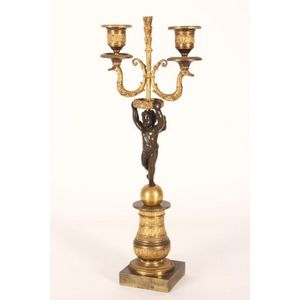19th Century French Bronze Cupid Candelabra
You must be a subscriber, and be logged in to view price and dealer details.
Subscribe Now to view actual auction price for this item
When you subscribe, you have the option of setting the currency in which to display prices to $Au, $US, $NZ or Stg.
- Palmette - A decorative motif used in the decoration of ceramics, textiles and furniture, based loosely on the palm leaf and sometimes used with the anthemion, from which it is often difficult to distinguish. The form of the palmette varies from ornate to simplistic.
- Sconce - A light attached to a wall. Originally a candle holder that is attached to a wall with an ornamental bracket and sometimes with a reflective back plate, but now applied to an electric light that has been inspired by that design.
In recent times the word has also come into use to desribe the candle holders on a candelabra. - Bronze - An alloy of copper and tin, traditionally in the proportions of about 9 parts of copper to 1 part of tin.
The discovery of bronze in Western Asia in the 4th century enabled people to create metal objects which were superior to those previoulsy possible because of its strength and hardness, and it has been used throughout the world for weapons, coins, tools, statuary and other decorative items.
It is very fluid in a molten state, and its hardness, strength when set, and non-corrosive properties makes it most suitable for casting sculpture. - Ormolu - Ormolu was popular with French craftsmen in the 18th and 19th century for ornamental fittings for furniture, clocks and other decorative items. True ormolu is gilt bronze, that is bronze that has been coated with gold using a mercury amalgam. Due to the health risks associated with using mercury, this method of creating ormolu was discontinued in France in the 1830s. A substitute was developed consisting of about 75% copper and 25% zinc, however it was inferior to the bronze version. It was often lacquered to prevent it tarnishing.
- Cupid Motif - The Cupid motif, which features the Roman god of love and desire, Cupid, was a popular decorative element in classical ornamentation. Cupid was often depicted as a winged, naked baby with a bow and arrow, and was often used to symbolize love and desire.
In classical art and architecture, Cupid motifs were often used as decorative elements on furniture, such as on the legs of chairs and tables, as well as on architectural elements such as friezes and pediments. They were also used as decorative elements in frescoes, mosaics, and other forms of art.
During the Renaissance, Cupid motifs were often incorporated into the decoration of palaces, churches and other grand buildings, as they were seen as symbols of love and fertility. Cupid motifs were also commonly used in the decorative arts of the Baroque period, often appearing in the form of putti, which are small winged cherub figures.
In addition to their decorative use, Cupid motifs were also believed to hold symbolic meaning, as they were thought to evoke feelings of love, desire, and fertility.
This item has been included into following indexes:
-
candelabra / candelabrum
- French 170
- ormolu and bronze 202
- candlesticks, types - French 169
Visually similar items

Silver plated five branch ornate candelabrum with a pull out conversion for a single stem candlestick. Maker Dixon T. & Co height 74.5 cm

An Italian marble urn on pedestal carved with grapes and floral garland, late 19th century. Provenance: The Nick Raftopoulos Collection, Melbourne

A pair of Regency figural candelabra, circa 1830, each raised on a stepped marble base and cylindrical bronze standard surmounted by a classically draped figure holding a scrolling two branch candelabra aloft, 56 cm high

Austro-Hungarian silver pair of candlesticks with a lotus form bowl, a four corner tree form stem with four lions below, each acting as guardians protecting from four attacking vipers. Weighted bases. Maker Rs. Height 34 cm
